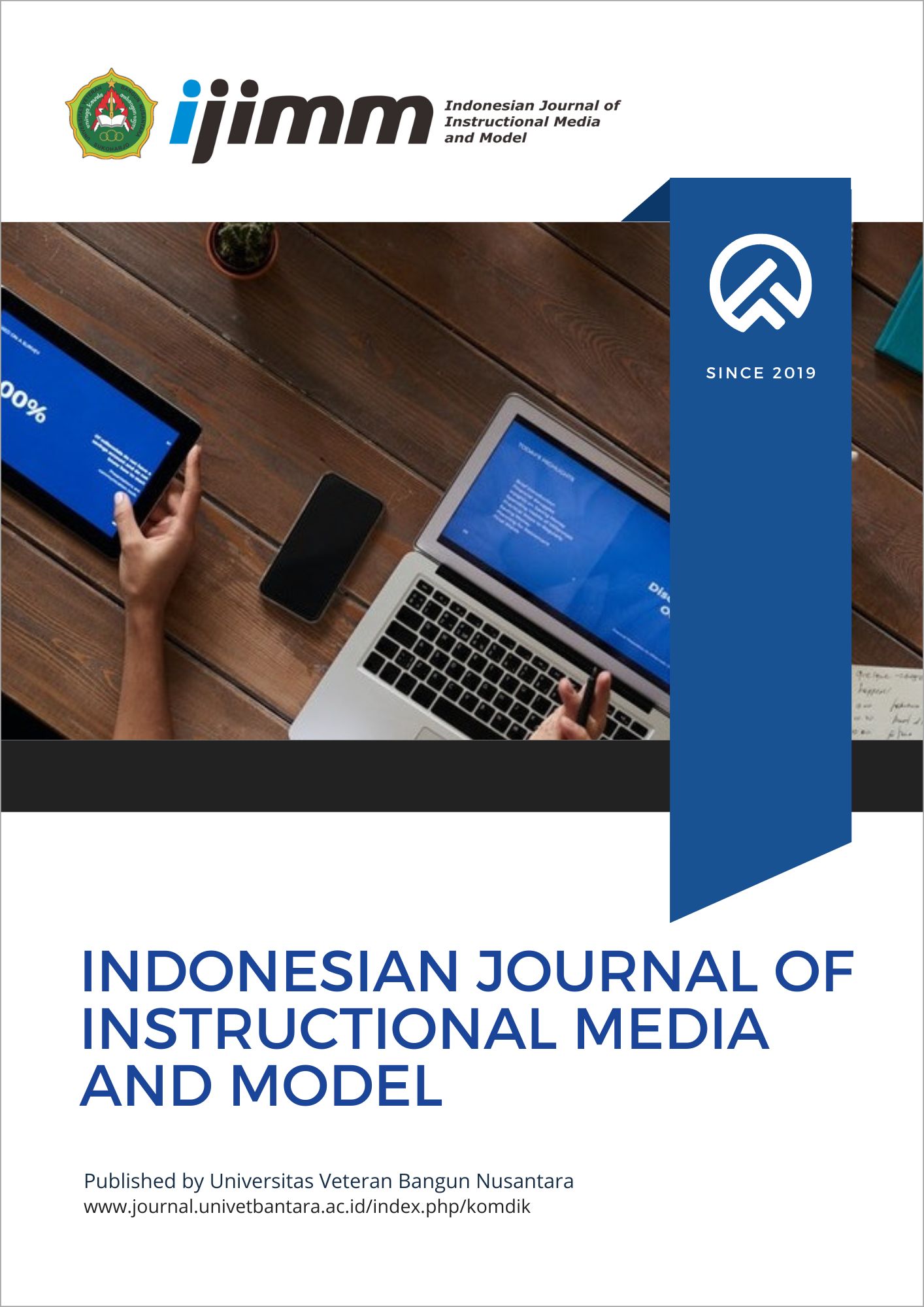Using Gamification Applications to Increase The Student's Learning Activity in Digital Simulation Subjects
DOI:
https://doi.org/10.32585/ijimm.v4i2.2856Keywords:
Student's Learning Activity, Digital Simulation, GamificationAbstract
The pandemic covid-19 over the past two years made major changes in the education world especially students, at which time the practice of face-to-face learning trials took place especially in the army of veteran 1 sukoharjo. The problem with face-to-face learning is that students lack the focus of learning during the teaching process, and students are inactive or lack confidence in expressing. Suggested that the process of using elements that are implemented in each activity that has no game elements and therefore provides an unsaturated effect. The purpose of this study is to increase the activation of class x TBSM students in veteran 1 sukoharjo with application of gamonification. Research methods are class action studies, using the four stages of planning, action, observation, and reflection done with the 3 cycles of pre cycles, cycles I, and cycles ii. The subject of this study is an x TBSM student at veteran 1 sukoharjo high school. The media employed in research is kahoot! And quizziz. The instrument used is the student's activity observation sheet. The data analysis technique used is a quantitative description. The study then obtained an average value-an average of 63.24 % (active criteria) on the I cycle, then with the teacher making repairs can, increasing activation to the ii cycle 81.62%. Results from test t in pairs, score alpha 0.05 acquired.
Downloads
References
Aqib, Z., & Amrullah, A. (2019). Manajemen Belajar dan Pembelajaran di Sekolah (F. S. Suryantoro (ed.); 1st ed.). Pustaka Referensi.
Claudia, M., & Anggraeni, D. (2021). Efektivitas Penggunaan Metode Latihan dan Penugasan dalam Pembelajaran Daring di Masa Pandemi pada Mata Pelajaran PKN di Sekolah Dasar. Jurnal Pendidikan Tambusai, 5(1), 874–883.
Gutiérrez, J. R. L., Ponce, P., & Msolina, A. (2021). Real-Time Power Electronics Laboratory to Strengthen Distance Learning Engineering Education on Smart Grids and Microgrids. Future Internet, 13(237), 1–16.
Halik, A., & Aini, Z. (2020). Analisis Keaktifan Siswa dalam Proses Pembelajaran Daring di Masa Pandemi COVID-19. Enlighten: Jurnal Bimbingan Konseling Islam, 3(2), 131–141.
Jusuf, H. (2016). Penggunaan Gamifikasi dalam Proses Pembelajaran. Jurnal TICOM, 5(1), 1–6.
Mahfudah, H., Wijoyo, S. H., & Afirianto, T. (2021). Analisis Penerapan Gamifikasi Pada Model Blended Learning Terhadap Hasil Pembelajaran Desain Grafis (Studi Kasus : SMK Negeri 10 Malang). Jurnal Pengembangan Teknologi Informasi Dan Ilmu Komputer, 5(7), 3055–3061. https://j-ptiik.ub.ac.id/index.php/j-ptiik/article/view/9472
Marisa, F., Akhriza, T. M., Maukar, A. L., & Wardhani, A. R. (2022). JOINTECS. Journal of Information Technology and Computer Science, 3(28), 219–228.
Merpati, T., Lonto, A. L., & Biringan, J. (2018). KREATIVITAS GURU DALAM MENINGKATKAN HASIL BELAJAR SISWA DI SMP KATOLIK SANTA ROSA SIAU TIMUR KABUPATEN SITARO. Jurnal Civic Education, 2(2), 55–61.
Murni, N. F. (2021). UPAYA MENINGKATKAN KEAKTIFAN SISWA DALAM PROSES PEMBELAJARAN. Science, Engineering, Education, and Development Studies (SEEDS): Conference Series, 5(1), 7–11.
Octafiana, W., Ekosusilo, M., & Subiyantoro, S. (2018). PENGEMBANGAN MULTIMEDIA INTERAKTIF PADA MATERI PESAWAT SEDERHANA UNTUK SISWA SEKOLAH DASAR. Jurnal Komunikasi Pendidikan, 2(2), 168–175.
Ouariachi, T., Li, C., & Elving, W. J. L. (2020). Gamification Approaches for Education and Engagement on Pro-Environmental Behaviors : Searching for Best Practices. Sustainability, 12(4565), 1–14.
Oxarart, R. A., & Houghton, J. D. (2021). A Spoonful of Sugar : Gamification as Means for Enhancing Employee Self-Leadership and Self-Concordance at Work. Administrative Sciences, 11(35), 1–16.
Pohan, A. E. (2020). KONSEP PEMBELAJARAN DARING BERBASIS PENDEKATAN ILMIAH (Susilawati (ed.); 1st ed.). CV SARNU UNTUNG.
Putra, H. K., Pamungkas, B. S., & Pamungkas, D. S. (2020). Implikasi Distance Learning berbasis Whatsapp Materi Pembelajaran Simulasi Digital untuk Kelas X SMK. Edudikara: Jurnal Pendidikan Dan Pembelajaran, 5(4), 217–230.
Salsabila, U. H., Zulnadi, I. G., Khoirunnisa, N., & Hanifah, H. (2020). Strategi Alternatif Pembelajaran Daring Mahasiswa Pendidikan Agama Islam Pada Masa Pandemi Covid-19. Jurnal Edusciense, 7(2), 78–88.
SM Zaid. (2021). Ekuitas Merek dan Advokasi Pelanggan Melalui Strategi Gamifikasi dan Kualitas Pelayanan (S. Anam (ed.); I). Academia Publication.
Suardi, M. (2018). Belajar dan Pembelajaran (1st ed.). Penerbit Deepublish.
Suarim, B., & Neviyarni. (2021). Hakikat Belajar Konsep pada Peserta Didik. Edukatif : Jurnal Ilmu Pendidikan, 3(1), 75–83.
Yudi Firmansyah, & Fani Kardina. (2020). Pengaruh New Normal Ditengah Pandemi Covid-19 Terhadap Pengelolahan Sekolah Dan Peserta Didik. Buana Ilmu, 4(2), 99–112. https://doi.org/10.36805/bi.v4i2.1107
Downloads
Published
How to Cite
Issue
Section
License
Authors who publish with the Indonesian Journal of Instructional Media and Model agree to the following terms:
- Authors retain copyright and grant the journal the right of first publication with the work simultaneously licensed under a Creative Commons Attribution License (CC BY-SA 4.0) that allows others to share the work with an acknowledgment of the work's authorship and initial publication in this journal.
- Authors are able to enter into separate, additional contractual arrangements for the non-exclusive distribution of the journal's published version of the work (e.g., post it to an institutional repository or publish it in a book), with an acknowledgment of its initial publication in this journal.
- Authors are permitted and encouraged to post their work online (e.g., in institutional repositories or on their website) prior to and during the submission process, as it can lead to productive exchanges, as well as earlier and greater citation of published work.





